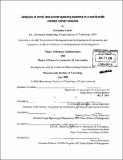Analysis of email and phone queuing systems in a world-wide contact center network
Author(s)
Carter, Kristopher (Kristopher W.)
DownloadFull printable version (6.173Mb)
Other Contributors
Leaders for Manufacturing Program.
Advisor
Deborah Nightingale and Stephen Graves.
Terms of use
Metadata
Show full item recordAbstract
Contact centers are operated by companies to answer customer inquiries via phone calls or email. Customers often equate the service they are provided while interacting with a contact center to the quality of a company's product offering. Therefore, a major concern is what service level the company should choose to provide. One means of measuring service level is speed of response (how quickly a customer inquiry is answered). In general, faster response requires more customer service agents for a given volume of inquiries. Phone response times are usually measured in minutes or seconds. Email response times are usually measured in hours or days. This paper examines customer expectations regarding email and phone inquiry response time, and examines various models for planning staffing requirements to meet these response times. The expectations for response time to phone calls are found to be stable, having not changed much in the last few decades. The expectations for response time to email inquiries have been increasing though, with customers demanding much faster response in the last few years. Many customers now expect response to their emails within hours rather than days, with a significant number now expecting response as quickly as one hour. The challenges of implementing faster response times to email are examined using a case study at a major online retailer. A model is also introduced for email service level planning, that allows for the fact that typical response times are much longer than for phone calls.
Description
Thesis (M.B.A.)--Massachusetts Institute of Technology, Sloan School of Management; and, (S.M.)--Massachusetts Institute of Technology, Dept. of Aeronautics and Astronautics; in conjunction with the Leaders for Manufacturing Program at MIT, 2008. Includes bibliographical references (p. 50).
Date issued
2008Department
Leaders for Manufacturing Program at MIT; Massachusetts Institute of Technology. Department of Aeronautics and Astronautics; Sloan School of ManagementPublisher
Massachusetts Institute of Technology
Keywords
Sloan School of Management., Aeronautics and Astronautics., Leaders for Manufacturing Program.